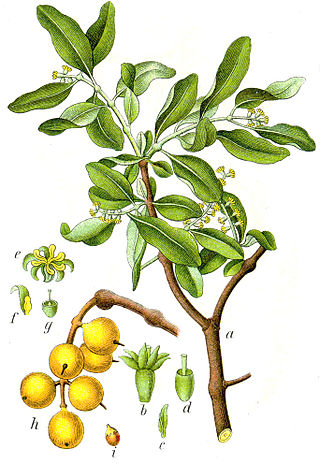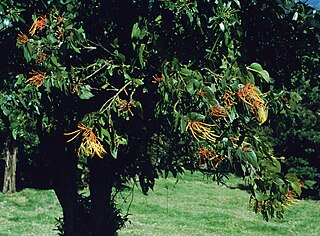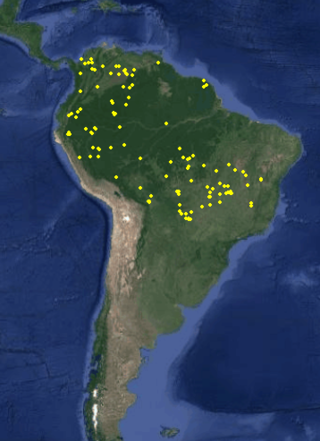
Paubrasilia echinata is a species of flowering plant in the legume family, Fabaceae, that is endemic to the Atlantic Forest of Brazil. It is a Brazilian timber tree commonly known as Pernambuco wood or brazilwood and is the national tree of Brazil. This plant has a dense, orange-red heartwood that takes a high shine, and it is the premier wood used for making bows for stringed instruments. The wood also yields a historically important red dye called brazilin, which oxidizes to brazilein.

Carl Friedrich Philipp von Martius was a German botanist and explorer. Between 1817 and 1820, he travelled 10,000 km through Brazil while collecting botanical specimens. His most important work was a comprehensive flora of Brazil, Flora Brasiliensis, which he initiated in 1840 and was completed posthumously in 1906.
Athroostachys is a Brazilian genus of bamboo in the grass family.

Verbena brasiliensis, the Brazilian verbena or Brazilian vervain, is a flowering plant species from the vervain family (Verbenaceae). It is native to parts of South America, namely Brazil, but has spread its range in recent times and has occasionally become an invasive weed. It is an annual plant with purple flowers, and it has been introduced outside of its native range as an ornamental plant, and is now largely considered an invasive weed in these regions.

Loranthus is a genus of parasitic plants that grow on the branches of woody trees. It belongs to the family Loranthaceae, the showy mistletoe family. In most earlier systematic treatments it contains all mistletoe species with bisexual flowers, though some species have reversed to unisexual flowers. Other treatments restrict the genus to a few species. The systematic situation of Loranthus is not entirely clear.

Dipteryx charapilla is a little-known species of flowering plant in the family Fabaceae, a large to mid-sized tree growing along rivers in the rainforests of Brazil. and Peru.

Butia eriospatha is a small species of Butia palm endemic to the highlands of southern Brazil. It is very similar to B. odorata, but is easily distinguished from this species by the distinct spathes which are densely covered in rust-coloured, woolly hairs. Indeed, the specific epithet is derived from Greek ἔριον, wool, and Latin spatha, which refers to the spathe. It has been given the name woolly jelly palm (UK) or wooly jelly palm (US) in English. Vernacular names for it where it is native are butiá-da-serra, butiázeiro, butiá-veludo, butiábutiá verdadeiro, butiá-do-campo, yatáy and macumá.

Strophocactus brasiliensis, synonym Pseudoacanthocereus brasiliensis, is a species of plant in the family Cactaceae. It is endemic to Brazil. Its natural habitats are subtropical or tropical dry forests and hot deserts. It is threatened by habitat loss.

Psittacanthus, also parrot-flower, is a plant genus in the family Loranthaceae. It is a type of mistletoe native from central Mexico southwards to Central America and parts of South America.

Psittacanthus robustus is a species of Neotropical mistletoe in the family Loranthaceae, which is found in Brazil, Colombia, Guyana, and Venezuela.
Louis Auguste Joseph Desrousseaux was a French botanist and pteridologist. He was a contributor to the "Encyclopedia Botanique" of Lamarck, from 1783 to 1796.

Psittacanthus calyculatus,, is a species of Neotropical mistletoe in the family Loranthaceae, native to Colombia, Mexico, the Mexican Gulf, and Venezuela.

Psittacanthus cordatus is a species of Neotropical mistletoe in the family Loranthaceae, which is native to Bolivia and Brazil.

Psittacanthus schiedeanus G.Don is a species of Neotropical mistletoe in the family Loranthaceae, which is native to Panamá, Costa Rica, Honduras and Mexico.

Psittacanthus acinarius is a species of mistletoe in the family Loranthaceae, which is native to Bolivia, Brazil, Colombia, Costa Rica, Ecuador, Peru, Venezuela, and French Guiana.
Psittacanthus biternatus is a species of mistletoe in the family Loranthaceae, which is native to Brazil, Venezuela, and Colombia.

Psittacanthus cucullaris is a species of mistletoe in the family Loranthaceae, and is native to Costa Rica, Bolivia, Colombia, Ecuador, French Guiana, Peru, Suriname, Venezuela and Brazil.

Symphyotrichum martii is a species of flowering plant in the family Asteraceae endemic to Minas Gerais, Brazil. It is a perennial, herbaceous, hairless plant whose flowers have about 30 white ray florets.
Arjona megapotamica is a rare species of flowering plant in the family Schoepfiaceae, native to a small area of southeastern Brazil, where it grows in cool mountain grasslands. Like other Arjona species, it is thought to be a root hemiparasite. It is a small perennial plant growing as a bunch of short twigs from a woody central knob. As of December 2021, Arjona schumanniana was regarded by some sources as a synonym, by others as an independent species.
Elton Martinez Carvalho Leme is a Brazilian who is employed as a judge. He is also a self-taught botanist with a special interest in bromeliads. As of November 2022, the International Plant Names Index listed 629 scientific names which include Leme as a publishing author, including 13 generic names.














